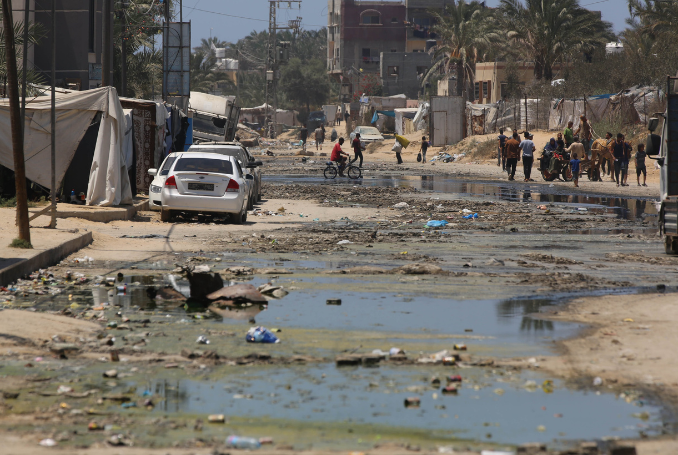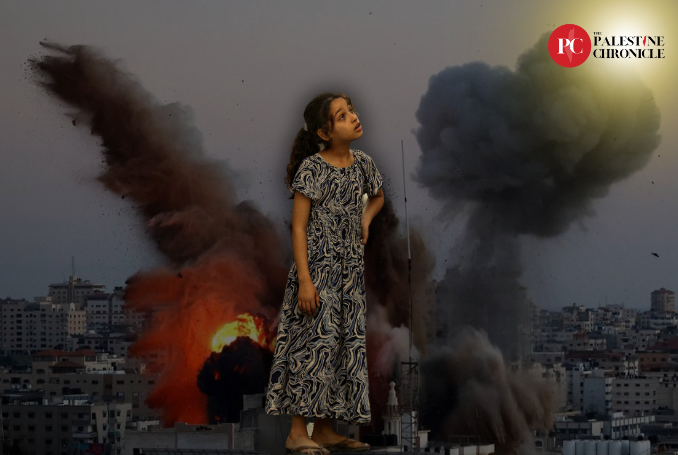
United Nations-affiliated organizations and other international groups have repeatedly highlighted the issue, but little has been done to improve Gaza’s horrific conditions.
Israel’s ongoing military campaign in Gaza has created an environmental catastrophe that threatens both immediate and long-term health risks for Palestinians, according to experts and recent reports, Anadolu news agency reported.
The ongoing Israeli war on Gaza has forced over 85 percent of Gaza’s population from their homes, leaving many in makeshift shelters amid mounting piles of garbage and debris.
Local authorities struggle to manage waste collection due to fuel shortages and damaged infrastructure.
United Nations-affiliated organizations and other international groups have repeatedly highlighted the issue, but little has been done to improve Gaza’s horrific conditions.
A recent report by the Netherlands-based organization, PAX for Peace, titled “War and Garbage in Gaza” paints a grim picture of the Territory’s waste management crisis.
? Time for the world to listen to the children of #Gaza
"I have been in the same clothes since the war started."
"Our streets are destroyed & full of garbage."
"I want to go back to my school and friends."
"I am sick of this life."
Their only hope is an immediate #Ceasfire pic.twitter.com/w3AFsxucUG
— UNRWA (@UNRWA) May 28, 2024
According to the report, at least 225 waste collection sites of varying sizes dot the Gaza Strip, but Israeli military operations have damaged collection vehicles and blocked access to disposal areas.
The result is hundreds of thousands of tons of solid waste accumulating in streets and fields.
‘Silent Threat’
Some 330,000 tons of solid waste have accumulated across Gaza – enough to fill more than 150 soccer fields – according to estimates by the UN Agency for Palestinian Refugees (UNRWA).
This is a “silent threat” to displaced Palestinians, the report warns, citing high temperatures, collapsed health infrastructure, food insecurity and a lack of medical care as compounding factors.
Health risks are severe.
STARVING CHILDREN SEARCHING THE GARBAGE FOR FOOD
No food in North Gaza
Starvation
Humanity has failed them
War Crimes pic.twitter.com/cvZssEMrDA
— Sulaiman Ahmed (@ShaykhSulaiman) February 14, 2024
“While the effects of the war on Gaza’s health infrastructure have been widely televised, the lens failed to capture the situation unraveling just outside the region’s remaining hospitals. With no proper disposal mechanisms, medical products are dumped in the open. When improperly treated, such waste can release chemicals and radioactive substances into the earth or underground water, leading to the spread of diseases like Hepatitis B and C,” the PAX for Peace report said.
Contaminated water and soil also threaten to enter the food chain through agricultural activities, potentially impacting ecosystems and populations far beyond Gaza’s borders, the report underlined.
Gaza produces around 2,000 tons of waste daily, managed by 500 donkey carts and 76 collection vehicles. One collection vehicle serves about 21,000 people there, according to the UN Development Program (UNDP).
With the amount of waste Gaza produces, protecting Gazans from epidemics and restoring the degraded environment is a long and difficult challenge.
Uninhabitable
But the crisis extends beyond solid waste. Seyfi Kilic from Turkiye’s Mugla Sitki Kocman University told Anadolu that Israel’s actions have made environmental problems in Gaza, including waste disposal, “inextricable.”
Kilic argues that this is part of a long-standing Israeli policy to make Palestinian Territories uninhabitable. He cites international laws prohibiting environmental modification techniques in warfare, suggesting Israel’s intensive use of conventional weapons aims to render Gaza unlivable.
“Gaza has always faced major issues with water supply and solid and liquid waste disposal due to the lack of full authority, the Israeli embargo and other reasons,” he said. “But this severe Occupation has made it even more intractable. This is Israel’s primary goal.”
The environmental damage could have lasting consequences, Kilic warns, adding that untreated waste and building debris could lead to outbreaks of malaria, cholera, typhoid and typhus. He views this as part of Israel’s military strategy to prevent Palestinians from living in Gaza.
West Bank, Too
Kilic also notes Israel’s history of damaging Palestinian agricultural land in both Gaza and the West Bank.
“Israel aims to transform both the West Bank and Gaza into areas unsuitable for agriculture,” he said.
Efforts to address waste management in Gaza existed before the current conflict, but Israeli restrictions meant most wastewater was released untreated into the sea or soil.
Now, with millions of people constantly displaced and living in tents, Kilic believes organizing any waste management is nearly impossible.
“The most important thing for these people right now is survival – access to enough food,” he said, noting reports of children and infants dying of starvation.
“This is all a result of policies aimed at genocide. It’s beneficial to view all of this as a consequence of Israel’s genocide policy.”
Genocide Continues
Flouting a UN Security Council resolution demanding an immediate ceasefire, Israel has faced international condemnation amid its continued brutal offensive on Gaza.
Currently on trial before the International Court of Justice for genocide against Palestinians, Israel has been waging a devastating war on Gaza since October 7.
According to Gaza’s Ministry of Health, 39,677 Palestinians have been killed, and 91,645 wounded in Israel’s ongoing genocide in Gaza starting on October 7.
Moreover, at least 11,000 people are unaccounted for, presumed dead under the rubble of their homes throughout the Strip.
Israel says that 1,200 soldiers and civilians were killed during the Al-Aqsa Flood Operation on October 7. Israeli media published reports suggesting that many Israelis were killed on that day by ‘friendly fire’.
Palestinian and international organizations say that the majority of those killed and wounded are women and children.
The Israeli war has resulted in an acute famine, mostly in northern Gaza, resulting in the death of many Palestinians, mostly children.
The Israeli aggression has also resulted in the forceful displacement of nearly two million people from all over the Gaza Strip, with the vast majority of the displaced forced into the densely crowded southern city of Rafah near the border with Egypt – in what has become Palestine’s largest mass exodus since the 1948 Nakba.
Later in the war, hundreds of thousands of Palestinians began moving from the south to central Gaza in a constant search for safety.
(Anadolu, PC)







